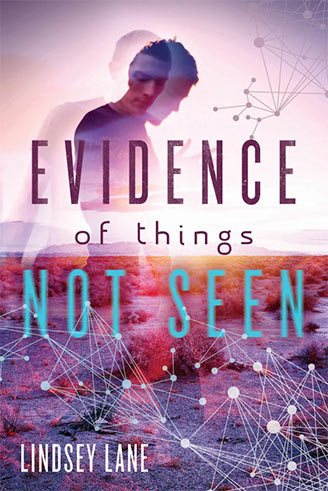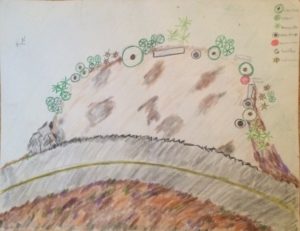 This month I read a YA novel that defies literary convention. It’s a mystery, but not a mystery. There’s a protagonist, but he goes missing. Scraps of paper found near the spot where he was last seen refer to particle physics and time travel. Characters hint at one possibility after another, and in the end… no, no, no, I can’t reveal the ending!
This month I read a YA novel that defies literary convention. It’s a mystery, but not a mystery. There’s a protagonist, but he goes missing. Scraps of paper found near the spot where he was last seen refer to particle physics and time travel. Characters hint at one possibility after another, and in the end… no, no, no, I can’t reveal the ending!
When I asked the author to tell me about her writing process, she mentioned a number of people who helped her along the way—a testament to the strength of her writing community. The author is Lindsey Lane, the book is her YA debut, Evidence of Things Not Seen (Farrar Straus Giroux 2014), and today I’m thrilled to feature her on my blog.
A.B. Westrick: Lindsey, I’m so glad I caught up with you to talk about this story.
Lindsey Lane: Thanks for tracking me down!
ABW: I love the way you open this novel with a missing teen. Then you go into a series of vignettes, each with different characters, and the story arrested me. The structure brought to mind Elizabeth Strout‘s Olive Kitteridge, and I wondered if that book influenced you. Could you talk a bit about how you conceived of this story?
LL: Elizabeth Strout?!?! Really? What a huge compliment. But no, no influence whatsoever.
Okay so here’s what happened. I went to VCFA as a picture book writer. I wanted to expand as a writer, and my first advisor, Sarah Ellis, suggested I try some short stories. So like a dutiful first semester student, I did. I wrote short stories…Bad ones. In my third semester, I had this dream. A young boy was standing in the middle of a pull out. Hmmm, I thought…who are you? I kept writing into that dream, trying to figure out who this kid was and where he was standing. Many, many drafts later, that boy became Nino in the chapter I titled, “Comic Book.”
To be honest, I didn’t know I was writing a novel. For a long time, I was writing connected short stories around this interesting place: a pull out by the side of the road. Finally when I had amassed quite a few stories, I dumped them into the laps of my critique pals. One of them, Anne Bustard, said, “Ummm, this story with the boy who goes missing? That story has some legs.” That’s when I began reimagining the whole thing and weaving in Tommy as a missing person throughout all of the stories.
ABW: That speaks to the value of listening to your writing colleagues. Also, a willingness to experiment with structure.
 LL: I like interesting structures. Years ago, I wrote a one woman play called The Miracle of Washing Dishes. Each character’s story was centered on washing dishes and having a kind of epiphany doing that simple act. It was based on the teachings of Thich Nhat Hanh and the notion that one can find joy and meaning in the simplest act. So I wove a whole bunch of characters together through a sink full of dishes. (The actor was amazing.)
LL: I like interesting structures. Years ago, I wrote a one woman play called The Miracle of Washing Dishes. Each character’s story was centered on washing dishes and having a kind of epiphany doing that simple act. It was based on the teachings of Thich Nhat Hanh and the notion that one can find joy and meaning in the simplest act. So I wove a whole bunch of characters together through a sink full of dishes. (The actor was amazing.)
I like story structures that have space for the audience to enter in and make connections. Remember when sitcoms were one storyline? Now they have three or four. Look at Modern Family. Or Transparent. As writers, we can ask the audience to lean in and make connections. We don’t have to spell everything out. I think television and movie writing is changing the way we tell stories on the page.
ABW: I remember marveling at the multiple story lines in Seinfeld, back in the early nineties. (Okay, now I’m dating myself. Back to Evidence…) Because Tommy is missing, we get to know him through the other characters’ eyes. I expected Tommy would eventually emerge as the protagonist, but that doesn’t happen, not really. Along the way, I thought maybe the sheriff would become the protagonist because, after all, he’s the Sherlock Holmes figure, trying to solve the mystery. But then again, you don’t show us the sheriff! We hear characters answering his questions, and never see him in the flesh. Brilliant! So I ended up thinking that the book didn’t have a protagonist, and yet the story had me on the edge of my seat. Would it be appropriate to view the group of characters as a collective protagonist? Or do you see Tommy as the protagonist in absentia?
LL: In my mind, Tommy is the protagonist. Though he never appears, he drives the narrative of the story by making every one else’s story wobble. You remember I did my VCFA graduate lecture on Alexander Calder [known for inventing the mobile]? In a way, the structure of Evidence is very much like a mobile: the negative space defines the creation. Does that make sense?
ABW: Yes. And it’s fascinating.
LL: To put it in more concrete terms: what happens when you can’t find your keys? Think how that happenstance alters your day. Now imagine if a kid disappears from a town. I was trying to see what would happen with all the people whose lives Tommy touched. What happens when he is gone? What happens to the people on the periphery? Do their lives wobble too? I think when something dramatic happens in our lives, we feel it, even if we don’t know that person.
ABW: I definitely felt the wobbling. Everything wobbled in the wake of Tommy’s disappearance, including the sheriff’s investigation.
LL: Ahhh, the Sheriff. Yes, of course he had to be there. The confessor. The bringer of hope. For his role, I need to tip my hat to Janet Fox. She used a cop in a very similar way in Sirens and it worked.
ABW: How challenging was it for you to craft so many different voices? Were some based on people you know, and others purely from your imagination? Who was the hardest for you to write?
LL: I loved using my theatre background to write the first person direct address sections with all the different voices. They moved the story forward.
The most challenging part wasn’t writing a particular character, but was believing it was okay to tell this story in such a different format. It was a risk. Many of the characters came from real life, both from my life and from my time as a journalist. (Karla Raye. Frank and Stella.) Others I imagined. (Alvin. Jake. Mary Louise.) They all seemed like kids who would go to that high school. I even put myself in the novel as a cameo. Who, you wonder? That girl who shows up in her blue truck in the pull out to buy a watermelon from Jake was me. In a former life.
ABW: Love it. Now I have to re-read that chapter with you in mind!
LL: That was fun to do. None of the characters were hard to write, but there is always a moment in the writing that is hard. For me, most of the hardness comes from my own self-doubt and wondering, “Can I do it? Is this character believable?” Then there is a moment when I fall in love with the character and I have to make them come to life. No matter what.
ABW: The setting emerges as a constant: the pull out on the side of a highway. The place where Tommy’s bike is found. The colors, sounds, and smells of the pull out with its cedar trees and fields beyond are now vivid in my mind. How did you craft this setting?
LL: Ohmigosh, the pull out. What a strange place, eh? I have to say the poet Julie Larios really pushed me on the setting. I listened to all those world-building lectures at VCFA and thought, “Oh, that’s for fantasy writers. I write contemporary realism. My world is the one we live in. I don’t need to worry about world building.” Au contraire, young grasshopper. Julie said, “Every writer needs to draw a map of their world. It must be detailed. So you know where everything is.”

So I drew a map of the pull out. I even made a legend for every tree. Finally, I shaded in all the divots and potholes of the pull out. I knew what it would feel like for Jake to walk across that pull out.
Setting is an amazing resource for a writer. Usually when I’m stuck, I can go to the setting and source a character’s memories and hopes. I may never use that material but it definitely deepens the character and I can usually move the story forward more organically.
ABW: Did you base this fictional pull out on a real place? A place that has affected you personally?
LL: When I moved from the east coast to Texas, I would see these strange little dirt patches by the side of the road. Sometimes they were empty. Sometimes people were selling watermelon or deer jerky. Sometimes cars were parked there with no one in them. It doesn’t have an address and yet people know the place when you say, “I last saw Tommy at the pull out by the Stillwell Ranch.” Immediately, that location is real. So I thought, “Hey, if I can weave together a play around dirty dishes, why not set a novel in a dirt patch by the side of the road?”
ABW: That’s great. And you did it! And I love the way you wove in tidbits about quantum physics and the possibility of time travel, and how you raised questions about assumptions we make everyday. It’s such a thoughtful novel. But don’t let’s get ahead of ourselves! No spoilers here. I’ll just add that I think the questions you and your characters raise are larger than the story, itself. They’ve stayed with me, and I want to thank you for that.
LL: Thank you, Anne. Quantum physics was such an essential part of Tommy’s character. It consumed him. I could feel how those concepts would set a teenager’s brain on fire. No wonder comic books weave quantum theory into their storylines. They are fascinating theories. As for the ending, I tried to create a novel that didn’t have a bow at the end. I didn’t want people to close the book and be at peace. I wanted them to wobble a bit as well.
ABW: And you succeeded. And instead of asking about the ending, I’ll ask: what are you working on now?
LL: Well, I’m revising my latest novel. I need to restructure the ending. It is about a girl who commits a murder. It’s loosely based on a woman I’ve been visiting in prison for the last two years. She’s serving thirty years. But what struck me about her case is her accountability. When she was eighteen years old, she turned herself in. Wow, right? How many of us would be brave enough to admit our crime? She seemed like a heroine in search of redemption. Of course, I didn’t write the novel in a straight linear fashion. Oh no. There are two timelines and they form a kind of infinity loop. It works but I need to restructure the climax so the crime feels absolutely inevitable and absolutely avoidable. No small task. It will depend on character. So while restructuring the climax, I have to infuse the main characters with more guts, sinew and heart.
ABW: Sounds like a lot of work ahead of you.
LL: I’m ready to dig in. I let the novel rest over the summer while my agent Erin Murphy read it and made brilliant comments. In the meantime, I revised a short story, which came from the world of Evidence. It is a thread that wouldn’t let go of me. It takes place about four months after the end of the novel. The main character is Sam, the boy who works at the Whip In. He’s about to leave for college, and it’s his last shift at the Whip In. When it’s ready, I will let you know where you can find it.
 ABW: Thank you. I look forward to reading it. And thanks again for granting this blog interview!
ABW: Thank you. I look forward to reading it. And thanks again for granting this blog interview!
Readers: if you want to know more about Lindsey Lane and her writing, check out her website and look for her on facebook and Twitter. If you’re buying for a teen this holiday season, hey—take it from me. Evidence of Things Not Seen is a great read! And for little ones, consider her picture book, Snuggle Mountain.

Interesting way to plot. Thanks, Anne! Good job as usual. I’ll send this to some writer friends.
Thank you, Lenore. I haven’t yet tried this way of plotting, but the possibility intrigues me. And I was really impressed by the way Lindsey got inside each character’s head and body. She got me thinking about the value of theatrical training.
Thank you, Anne and Lindsey! This interview is well-timed for me, because I’m working on a historical novel with a collective protagonist made up of four individuals, one of whom dies in the first chapter. There’s also a dual timeline, one how they got to that point and the other the danger from which the three survivors must escape.
Great interview! I love the idea of a protagonist who isn’t present but still drives the narrative. Very unique!
Unique and risky and exactly what people tell you not to do in a debut, and yet Lindsey pulled it off!
Lyn – Your work-in-progress sounds great. I hope you get a chance to read EVIDENCE and notice how Lindsey succeeded in weaving together multiple perspectives. Good luck with it!
I’ve already read EVIDENCE OF THINGS NOT SEEN. I loved it!
Oh, good. Glad that you got the chance to read it. I look forward to reading your new novel with the collective protagonist!
Ah – how I love Lindsey’s novel!! And so proud I could inspire a tiny bit of its magic. Great interview! Hugs – j
I enjoyed surfing your website, Janet, and linking from this website to yours. I love that you say you write for and about the child — the teen — that you still are inside. I get that. Yup, I sure do.